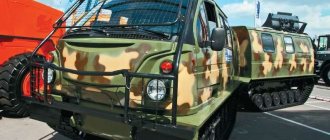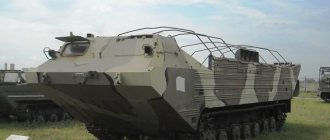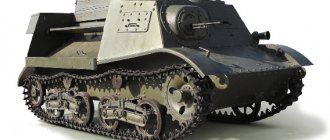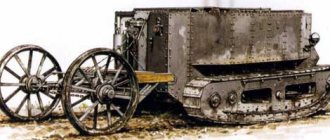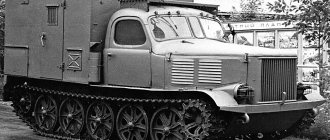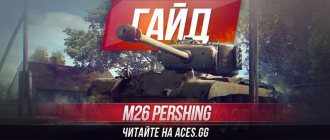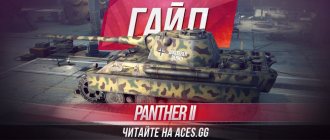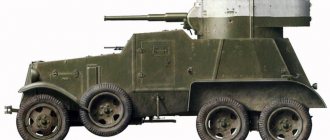| This article requires additional links for verification . |
Type of half-track artillery tractor
| Sd.Kfz. 7 | |
| Sd.Kfz. 7 at Militracks 2010, Overloon | |
| Type | Half-track artillery tractor |
| Place of origin | Nazi Germany |
| Service history | |
| In service | 1938 - 1945 (Nazi Germany) |
| Used | Nazi Germany, Italy, Romania, Bulgaria, Czechoslovakia (post-war), Allies (post-war) |
| Wars | The Second World War |
| Production history | |
| Designer | Krauss-Maffei |
| Developed | 1934 |
| Manufacturer | Krauss-Maffei, Borgward, Österreichische Saurer-Werke AG, Breda (Breda 61) |
| Unit cost | 36,000 Reichsmarks |
| Produced | 1938-1944 |
| No built | 12 187 |
| Options | Sd.Kfz. 7/1, Sd.Kfz. 7/2, Feuerleitpanzer auf Zugkraftwagen 8t, Breda 61 |
| Characteristics | |
| Weight | 11.53 tons |
| Length | 6.85 m (22 ft 6 in) |
| Width | 2.35 m (7 ft 9 in) |
| Height | 2.62 m (8 ft 7 in) |
| Crew | 1 driver |
| Passengers | 11 |
| Engine | Maybach HL62 TUK, six-cylinder petrol 135 hp (133 hp, 99 kW) |
| Power/weight | 12.1 hp / ton |
| Payload capacity | 1800 kg |
| Suspense | Torsion bar |
| Fuel tank capacity | 215 liters |
| Operating range | 250 km (160 miles) on road 120 km (75 miles) off-road |
| Maximum speed | 50 km/h (31 mph) on roads |
Sd.Kfz. 7
was a half-track military vehicle used by the German Wehrmacht Heer, Luftwaffe and Waffen-SS during World War II.
Sd.Kfz. it is short for the German word Sonderkraftfahrzeug
, "special purpose vehicle".
The longer designation is Sd.Kfz.
7 mittlerer Zugkraftwagen 8t , "medium 8t tractor".
Development[edit]
Development Sd.Kfz. 7 can be traced back to the Wehrmacht's 1934 requirement for an eight-ton (7.87 t) half-track chassis. Various prototype machines were built by Krauss-Maffei from 1934 to 1938. [1] The production vehicle first appeared in 1938 and was intended to be used primarily as a tractor for the 8.8 cm FlaK gun and the 150 mm 15 cm sFH 18 howitzer. Production stopped in 1944. The car was manufactured by Krauss-Maffei in Munich, Saurerwerke in Vienna and the Borgward plant in Bremen. [1] Due to its great power, it was often used as a recovery vehicle. [ citation needed
]
Birth of a legend
It is unlikely that there will be at least one film dedicated to the Second World War in which the German Sd.Kfz.7 half-track tractor did not appear. The impressive truck impressed with its appearance and capabilities.
The Sd.Kfz.7 appeared in 1933, when the National Socialist German Workers' Party, led by Adolf Hitler, came to power. The average 8-ton tractor was not initially considered as an indispensable workhorse. The fact is that half-track vehicles were completely inferior to wheeled competitors in reliability and maintainability. A complex structure could fail at the most inopportune (as if there were any right) moment. But there were also advantages, because of which the Germans turned a blind eye to the shortcomings. Firstly, the tractor was an indispensable “carrier” of guns. Secondly, its off-road capabilities were impressive.
The first production model appeared a year later. It was called BN m8. It received a 6-cylinder carburetor power unit and a towing capacity of eight tons. Accordingly, the tractor could tow 88-mm anti-aircraft guns.
But this option did not last long. Already in 1936 it was replaced by an improved model KM m9 with a 130-horsepower Maybach engine. A total of 12 tractors were produced, which could tow both anti-aircraft guns and 105 mm guns. The crew consisted of twelve people. The roof was still soft, so a tarpaulin awning hung over the soldiers, capable of protecting them only from rain.
Soon the KM m10 model appeared, which received a more powerful (140 hp) Maybach engine. In 1937, the KM m11 was released, which later became the Sd. Kfz. 7. This is where the creators stopped their search for the recipe for the ideal half-track tractor.
In general, the company that developed the Sd.Kfz.7 hit the bull’s eye. Büssing-NAG and Daimler-Benz also took part in the creation of the tractor. And when the Second World War began, the military remembered the universal vehicle. Already in 1939, full-scale mass production of tractors began. While the war was going on, the factories managed to produce more than twelve thousand cars. Moreover, the largest quantity was produced in 1944, when a total of 3352 Sd.Kfz.7 rolled off the production lines.
The production of vehicles was quite expensive. One tractor cost about forty thousand Reichsmarks. But, as you know, all means are good to win. In addition, in the period from 1943 to 1944, a radical change occurred in the war. The USSR managed to stop the advance of the Nazis in the east as a result of the victory achieved at the Kursk Bulge. The Allies opened a second front, which worsened the already shaken position of the Third Reich. Germany was desperately looking for a way to escape, so it invested all available funds in the creation of army equipment.
Description[edit]
The vehicle could transport artillery crews of up to 12 people in theater-type chairs. There was space under the seats to store various tools, and the entire car was spacious enough to accommodate a set of them. At the rear of the vehicle was a closed compartment for storing ammunition, although a second ammunition carrier was desirable. The tractor could tow loads up to 8,000 kg (17,600 lb). Most of them were equipped with a winch that could pull up to 3450 kg. [1] Its payload was 1800 kg. [2]The windshield could be folded and a canvas roof could be fitted. Some were also built with a hard top, but this was less common in service. A later simplified type appeared with a wood-frame truck layout, ammunition was stored behind the driver's seat, and the gun crew took place on wooden benches behind.
The chassis consisted of two front wheels with hydro-pneumatic tires for steering and a track on each side with 14 road wheels - 7 on each side, overlapping each other, and alternating in a general Schachtellaufwerk
designs for German half tracks - on each side of the vehicle; the drive sprocket was located at the front of each rail system. Minor changes to track and road wheel design and manufacturing took place during maintenance, some of which were combined in the field during repairs. In 1943, the Maybach HL62 engine was replaced by the Maybach HL64. [3]
Combat use[edit]
German army[edit]
The use of half-track tractors for artillery was common among German forces, but not everywhere. Compared to wheeled vehicles, half-tracks are more difficult to maintain, break down frequently, and are slower to travel on roads. However, they have greater off-road mobility compared to wheeled vehicles.
The Sd.Kfz.7 was used throughout the war. They were seen during the 1940 Victory Parade in Paris and Sd.Kfz. 7 clips in German wartime propaganda footage that contribute to the myth of the mechanized blitzkrieg. In fact, although they were produced in large quantities, there were never enough of them to fully equip German forces. Typically, like many other types, the artillery elements of tank and mechanized infantry units (Panzergrenadier) received them, while other units continued to rely on horses to pull their guns.
Aircraft Sd.Kfz. 7 were used extensively in the North African Campaign, where their tracks allowed them to move across the desert sands much more efficiently than trucks. Often convoys carrying troops or prisoners of war included at least two half-tracks with one common travel point to create a path across the sands that trucks could follow.
Sd.Kfz. 7/1 at Wehrtechnische Studiensammlung Koblenz
Aircraft Sd.Kfz. 7 also formed the basis for a number of variants of self-propelled anti-aircraft guns based on the 20 and 37 mm anti-aircraft artillery guns used. Aircraft Sd.Kfz. 7/1 was armed with the 4 mm Flakvierling 38 2 cm Flakvierling 38 anti-aircraft system. Aircraft Sd.Kfz. 7/2 was armed with a single 3.7 cm FlaK 36 anti-aircraft gun. On many of these variants, the driver's seat and engine cover were armored [1] (8 mm thick). [4] Conversions were also carried out with the installation of a single 2 cm anti-aircraft gun. Experimental vehicles with the 5 cm FlaK 41 installation were produced, but were unsuccessful and did not go into mass production. [1]
Option with armored superstructure based on Sd.Kfz. 7, Feuerleitpanzer auf Zugkraftwagen 8t, was used by the launch crews of the V-2 ballistic missile. This was necessary because the V-2 sometimes malfunctioned and exploded on the launch pad. [1] It was also used to tow the launch pad into place. Bunkers were not used as the V-2 was transported to widely dispersed launch sites on
Meillerwagen
trailers which could mount them on the launch stands/flash suppressors that each dispersed launch device was equipped with for surprise launches to avoid Allied air attacks.
Other armies[edit]
A Sd. Kfz. 7 vehicles of the Royal Hungarian Army, Hungary, 1944
A licensed copy, produced in Italy, was built during the war (designated Breda 61, [1] 250 produced [3] 1942-1944 [2] ) and is easily recognizable by its long bonnet and right-hand drive.
British improved copy[edit]
The British company Bedford Motors (a subsidiary of Vauxhall Motors) built an improved copy of the Sd.Kfz.7. Designated Bedford Tractor (BT) and codenamed Traclat (Tracked Light Artillery Tractor), it was to be a go-anywhere artillery tractor for 17-pdr, 25-pdr and 40mm Bofors guns, but as far as it is possible, built using existing parts and production capacity.
In 1943, the Ministry of Supply asked Vauxhall Motors to build a three-quarter tracked vehicle with the same track and rear suspension as found on the Sd.Kfz.7 medium artillery tractors. To this end, some of the captured half-tracks were sent back to Britain from Libya. Morris put them through a test and evaluation program with the aim of developing a similar machine for British use. Six prototypes were built for testing in 1944, but the war in Europe ended before mass production could be considered.
Unlike the German original, the Traclat was powered by two standard Bedford engines mounted side by side and connected to a common shaft; but, as in the original, when the steering wheel went beyond the smooth turn, the power was gradually transferred to the outer wheel and track.
In some ways, the Traclat was superior to its predecessor: ammunition boxes were accessible from outside the vehicle, and it also had power steering. [2] By early 1945, Vauxhall Motors had delivered prototypes to the Fighting Vehicle Test Establishment (FVPE) for formal testing in conditions ranging from arctic to tropical, and the vehicles performed admirably, being capable of one-for-two grade climbing and fording. water six feet deep; however, the war ended before mass production could be considered. [5]
In July 1946, a test vehicle was to tow a 25-pounder gun and limber, and counter a Crusader artillery tractor and an Alecto self-propelled gun. Although Traclat showed better performance, it got stuck in the mud. A number of the machines were sent to Germany for further testing, but this came to nothing due to the prohibitive cost, and since the existing tractors coped with combat conditions in Western Europe, there was no need for mass production. The twin standard Bedford engines produced a combined 136 hp. with a combined fuel consumption of 3.5 mpg (1.27 km/litre). Traclat reached a top speed of 30 mph (48 km/h). [6]
Allied use of Sd Kfz 7 [edit]
Some Sd.Kfz. 7 were adopted by the Allies after World War II. The Czechoslovak Army used them for several years after the war. [1]
The Tank Museum, Dorset, UK has a detailed assessment of a captured Sd.Kfz. 7 produced by Vauxhall Motors in 1942 under the Traclat project mentioned above.
Applications and modifications
During the war Sd. Kfz. 7 carried not only a wide variety of artillery weapons, but also carried twelve people in full combat ammunition. Thanks to a 6-cylinder carburetor engine with a volume of 6.2 liters and a power of 140 hp. the vehicle could accelerate to a maximum of 50 km/h, which was very, very good. The fuel tank contained 215 liters and this reserve was enough for 250 kilometers when driving on a regular road and 120 on a “crossroads”. Fuel consumption varied greatly depending on operating conditions, so the range could range from 80 to 160 liters per hundred kilometers.
It is known that during the war the Germans handed over several tractors to the allied Bulgarian army. Also, Sd.Kfz. 7 were used by the Yugoslavs. But not those who sided with the Third Reich, but the communist partisans led by Josip Broz Tito. Most likely, the soldiers managed to capture the vehicles during one of the battles. Unfortunately, there is no exact information whether the German tractors helped the partisans or whether their “services” were quickly abandoned.
Interesting fact: in 1939, the Germans sold thirty-two tractors to Brazil. But only five cars reached South America. Yes, and this happened in 1941. However, Sd.Kfz. 7 entered service with the Brazilian Army in 1942 and served until 1945. When Germany lost the war, it stopped supplying necessary spare parts across the ocean. And the Brazilian authorities decided to send the tractors into “retirement”.
The license for the production of tractors was purchased by the Italian company. During the Second World War, it produced approximately 250 vehicles under its own name “Semincmgolato Breda Tipo 61”. There were practically no differences between the Italian and German versions, with the exception of the power unit. The “Italian” received a motor with a power of 130 “horses”.
But Fiat took a different path. The company decided not to copy the “German”, but to create its own half-track tractor based on it. A prototype was created, which was never brought to mass production. The creation of the tractor was delayed, large financial influences were required, and then Italy completely withdrew from the war.
It is known that the British managed to capture several Sd.Kfz.7s in Africa. The British were so impressed by the German car that they decided to create something similar. No sooner said than done. Soon several VT half-track tractors appeared. But they turned out to be too crude, and the modifications looked long and expensive. Therefore, the project was canceled.
The tractors that ended up in the Czechoslovak army stayed in service the longest. There they remained at a combat post until the 60s. And only when the Sd.Kfz.7 completely exhausted their reserves were they abandoned.
As for modifications. There were quite a lot of them, because the tractor turned out to be prone to a variety of changes and modifications. For example, there was an interesting version of Sd.Kfz. 7/9, which was equipped with V-2 ballistic missiles. This modification received a kind of armored “superstructure” in the rear part, in which devices for missile guidance and communications “settled”. Moreover, if the need arose, the tractor could easily tow the launch pad itself, from which the rockets were launched.
You can also remember Sd.Kfz. 7/5 "Artemis", a tractor converted into an anti-tank self-propelled artillery unit. It housed the Soviet 76-mm F-22 divisional gun.
After the defeat of the Third Reich in World War II, the need for half-track tractors disappeared. Therefore, the story of Sd.Kfz.7 ended here.
Options [edit]
Sd.Kfz.
7 Basic Sd.Kfz. 7 tractors with an open body and theater seats for artillery crews. No reservation.
Sd.Kfz. 7/1
Sd.Kfz. 7 is armed with a four-seat Flakvierling 38 L/65 2 cm Flakvierling 38 L/65 anti-aircraft gun with an open and armored cockpit. 750-800 produced by the end of December 1944 [4]
Sd.Kfz. 7/2
Sd.Kfz.
7 is armed with a 3.7 cm FlaK 36 anti-aircraft gun (replaced in 1944 by the 3.7 cm FlaK 43). Again, both open and armored cockpits existed. By the end of January 1945, about 1,000 had been produced [4] Feuerleitpanzer auf Zugkraftwagen 8t
Observation and command post for the V-2 ballistic missile. Unknown numbers produced.
Breda 61
Licensed Italian copy of Breda, 250 copies produced [3] 1942-1944. [2]
Links[edit]
| Wikimedia Commons has media related to Sonderkraftfahrzeug 7 . |
- ^ abcdefgh Bishop, Chris (editor), Encyclopedia of World War II Weapons
, Sterling Publishing Company, Inc. (2002), ISBN 1586637622, pp.78-79 - ^ abcd Lepage, Jean-Denis, German Military Vehicles of World War II: An Illustrated Guide to McFarland's Cars, Trucks, Half-Tracks, Motorcycles, Amphibians and Other
Vehicles (2007), ISBN 9780786428984, pp. 141–142 - ^ abc Mittlerer Zugkraftwagen 8t Sd.Kfz.7 achtungpanzer.com accessed 22 July 2012
- ^ abc Jentz, Thomas L. (1998). Panzer Tracts 12 - Flak Selbstfahrlafetten and Flakpanzer
. Tank paths. pp. 15–21. - Ellis, Chris; Bishop, Denis (1971). World War II military transport
. 167 High Holborn London WC1V 6PH: Blandford. pp. 130–131. ISBN 0-7137-0702-X.CS1 maint: location (link) - Classic military magazine Car issue March 46, 2005
| vteGerman armored fighting vehicles of the Second World War | |
| Tanks |
|
| Self-propelled artillery unit |
|
| Assault guns |
|
| Tank destroyers (panzerjaeger, jagdpanzer) |
|
| Half tracks |
|
| Armored cars |
|
| Self-propelled anti-aircraft guns |
|
| Demolition machines |
|
| Prototypes |
|
| Proposed projects |
|
| Production of German armored fighting vehicles during World War II | |
Mittlerer Zugkraftwagen 8t (Sd.Kfz.7) \ Kraus-Maffey KM m11 Medium tractor-transporter
During the initial period of the war, one of the main tractors of the Wehrmacht were the Sd.Kfz.6 and Sd.Kfz.8, which were intended for towing heavy artillery systems. However, the army needed a tractor for the 150 mm sK18 cannons, which were especially important during offensive operations. In 1934-36. Kraus-Maffey has developed a whole series of specialized 8-ton tractors KM m8, KM m.9, RM m.10 and KM m11
.
The latter model was produced in the largest quantities and received the official designation Mittlerer Zugkraftwagen 8t (Sd.Kfz.7)
.
All of the above models were practically the same in appearance, since the modifications and improvements concerned mostly the power plant. The Sd.Kfz.7 tractor differed from them in its extended chassis and, with its own weight of 9750 kg, could develop a traction force of up to 8000 kg. The machine was also equipped with an engine-driven winch mechanism, which had a tractive effort of 3455 kg. Suffice it to say that this was sufficient for field artillery, and in addition, the Sd.Kfz.7 could tow medium tanks of the Pz.III and Pz.IV types.
The Kraus-Maffay tractor was built according to a classic design with a front-mounted engine and an automobile-type axle, which served for steering. The front wheels were single-pitch and equipped with conventional pneumatic tires measuring 9.75 x 20 inches. Suspension included leaf spring shock absorption. The tracked undercarriage, applied to one side, consisted of six road wheels installed in a checkerboard pattern, a front drive wheel and a rear guide wheel. The road wheels were equipped with a torsion bar suspension. Each caterpillar consisted of 54 steel tracks (each with a “tooth”) 360 mm wide and 180 mm long. The total length of the track chain was 9720 mm. The wheel track width was 1800 mm, the track width was 2000 mm. With a total weight of 9500 kg, the tractor had a specific ground pressure of about 0.59 kg/sq.cm. The maximum turning radius is 8 meters (according to other data - 16).
The KM m11 model was equipped with a 6-cylinder 4-stroke Maybach HL 62TUK gasoline engine with a displacement of 6191 cm3, which developed a power of 140 hp. at 2500 rpm. The engine was equipped with a Solex 40 IFF II carburetor, and a 2.5 hp starter was used to start it. Nearby was a fuel tank with a capacity of 213 liters. The fuel consumption of the tractor turned out to be close to that of tanks. For example, 100 km of driving on a highway required 80 liters of fuel, and 160 liters were required for a country road.
The transmission included the following components: a dry double-disc clutch, a manual gearbox with a range (8 forward speeds and 2 reverse), hydraulic and pneumatic brakes. The electrical system of the tractor used a current of 12 Volts, which was supplied from a battery with a capacity of 105 A/h. There was also a 130-watt electric generator.
In the open control compartment there were seats for the driver (on the right) and his assistant (on the left). The transport compartment could accommodate a gun crew of 9-10 people, ammunition or other ammunition weighing up to 1800 kg. In case of bad weather, a tarpaulin awning could be installed.
The first versions of the KM m11 were unarmored, but after assessing the harsh realities of the Eastern Front, it was concluded that protection was needed not only for the crew. There was no intention of turning the serial Sd.Kfz.7 into a full-fledged armored personnel carrier, but since 1942, a box assembled from 8 mm thick armor plates began to be installed on tractors. The armor completely covered the driver's cabin, but the transport compartment was only half closed - its front part had gable sides (like the Sd.Kfz.221 armored car) and was open at the top, and the rear was made in the form of an armored box - this modification was designated as Gepanzerte Zugkraftwagen 8t
. Late series tractors, starting in 1943, were equipped with a 203-liter fuel tank and a Maybach HL 64 engine.
During 1937-44. Kraus-Maffey enterprises assembled 5028 8-ton tractors of the KM m11 model. In 1938, Bogward joined their production, but no exact information has been preserved about this manufacturer. Further production of 8-ton tractors was launched at the factories of Saurer Werke AG in Austria and Breda in Italy. The total output was distributed as follows: 1939 - 1609 units, 1940 - 996 units, 1941 - 1322 units, 1942 - 1388 units, 1943 - 3250 units, 1944 - 3352 units. and 1945 - 270 pieces.
Vehicles of the Sd.Kfz.7 series were widely used on all fronts, and not only by the Germans - captured German tractors were popular both with us and with the allies. Of course, they transported not only 150 mm guns. Tractors were actively used for towing 88-mm anti-aircraft guns and other non-self-propelled artillery and ammunition. Tractors transferred to heavy tank destroyer battalions were only armored and designated Gepanzerte Zugkraftwagen 8t
.
Between 1941 and 1944, a number of Sd.Kfz.7s were supplied to the Bulgarian army. The cars were of both models, Borgward HL m11 and Krauss-Maffei KM m11. During the war, several 8-ton tractors were captured and subsequently used by Yugoslav partisans. Overseas buyers also showed interest in this successful vehicle - in particular, the Brazilian army was planning to purchase a batch of 32 Sd.Kfz.7s in an unarmored version. The contract was signed, but at the end of 1941 only 5 vehicles were delivered - the rest were requisitioned by the Wehrmacht to make up for losses. In Brazil, tractors were used until 1945 inclusive, as long as there were spare parts for them.
A separate story developed with the Italian version of the Sd.Kfz.7. The decision to produce it in-house was made in 1941 - for this purpose, the resources of the Breda company were allocated, which had to carry out work to adapt this tractor to the characteristics of the Italian industry. A slightly updated version was designated Semincingolato Breda Tipo 61
. A total of 250 units were assembled under German license. At the same time, the Italians tried to create their own half-track tractor based on the Sd.Kfz.7, but only a few prototypes were produced.
The 8-ton tractor also made a strong impression on the British army. In 1941, the Minister of Supply ordered Vauxhall Motors Limited to produce a copy of the German Sd.Kfz.7, but only 6 prototypes were assembled under the designation BT
.
In 1943, when the superiority of the Luftwaffe began to gradually decline, a program was launched to equip 8-ton tractors with 20-mm and 37-mm anti-aircraft systems. The chassis for such vehicles received the designation Sd.Kfz.7/1
and
Sd.Kfz.7/2
.
Also produced in small quantities were modifications Sd.Kfz.7/5 (Artemis - 7.62cm(r) Pak auf Zgkw 8t)
and
Sd.Kfz.7/6
, which were essentially specialized armored personnel carriers.
In addition, during 1944, some of the tractors were converted into trajectory measurement vehicles for A-4 (V-2) missile launch groups - the chassis for this model was designated Sd.Kfz.7/9
.
As of March 1, 1945, the Wehrmacht had 3,602 vehicles of this type. More than half of them survived to the end of the war. The tractors subsequently found use during the reconstruction of Germany; in the post-war army of Czechoslovakia they were in service until the end of the 1940s, while spare parts remained.
Sources: G.L. Kholyavsky “Encyclopedia of armored weapons and equipment. Wheeled and half-tracked armored vehicles and armored personnel carriers.” Minsk. "Harvest". 2004 P. Chamberlain, H. Doyle “Encyclopedia of German tanks of the Second World War 1933-1945” (translation by I.P. Shmelev), AST\Astrel\Harvest, Moscow\Minsk, 2003
TACTICAL AND TECHNICAL CHARACTERISTICS OF THE MEDIUM ARTILLERY TRACTOR Sd.Kfz.7 model 1937
| COMBAT WEIGHT | 9500 kg |
| CREW, people | 2 |
| DIMENSIONS | |
| Length, mm | 6850 |
| Width, mm | 2400 |
| Height, mm | 2620 |
| Ground clearance, mm | 400 |
| WEAPONS | — |
| AMMUNITION | — |
| AIMING DEVICES | — |
| RESERVATION (Gepanzerte Zugkraftwagen 8t) | front of the hull - 8 mm side of the hull - 8 mm rear of the hull - 8 mm roof - 8 mm bottom - 8 mm |
| ENGINE | Maybach HL 62TUK, carburetor, 8-cylinder, 140 hp. at 2500 rpm |
| TRANSMISSION | mechanical type: dry double-disc clutch, manual gearbox with range (8 forward and 2 reverse speeds), hydraulic and pneumatic brakes |
| CHASSIS | wheel part: automobile-type axle with two wheels, suspension on leaf springs, pneumatic tires track part (on one side): 6 road wheels with individual torsion bar suspension installed in a checkerboard pattern, front idler wheel, rear drive wheel, large crown caterpillar with metal tracks |
| SPEED | 65 km/h on the highway |
| HIGHWAY RANGE | 275 km |
| OBSTACLES TO OVERCOME | |
| Elevation angle, degrees. | ? |
| Wall height, m | ? |
| Fording depth, m | 0,65 |
| Ditch width, m | ? |
| MEANS OF COMMUNICATION | — |
